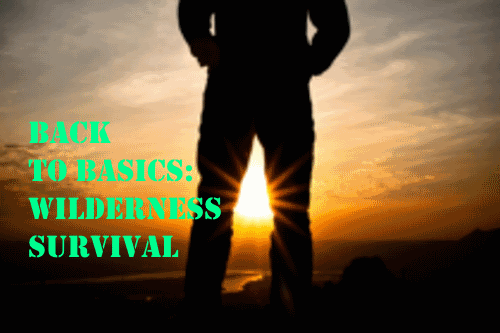When an outdoor accident occurs no matter how slight, or when you realize you are lost, panic is the first reaction we all must encounter and defeat before it brings on more harm. How you handle the effects brought on by panic can determine your rate of success or failure in any outdoor emergency situation.
Anyone can become lost, separated or stray too far from camp as night sets in. Just remember that you have within you the ability to protect yourself. Survival is a common element in all human beings, we do it everyday in the concrete and asphalt jungles of civilization… now you have to do it in the wilderness. The premise is the same, keep your wits, use your brain. DO NOT PANIC… let your positive self rule your decisions.
To emphasize the effect that panic has on an individual, let me familiarize you with the “RULES OF 3.” Experience has shown that you can only expect to survive a panic induced emergency situation for 3 seconds, you can only survive without oxygen or from severe bleeding for up to 3 minutes, you can survive exposure to excess heat or frigid cold for up to 3 hours and you can survive without food and water for up to 3 days. Panic is your major enemy, panic is the one thing you must overcome at once because panic can and will harm you.
To help you deal with panic lets look at a simple method of handling an emergency situation. Remember the acronym S.T.O.P. Sit -Think – Observe – Plan.
SIT: When you realize that you are lost take the time to sit down and collect your thoughts. You are not lost, you are right where you are, your camp, vehicle and everyone else is lost.
THINK: What do I have at my disposal both physical and mental that can help me in this situation. Take an inventory of your survival kit items and how you will use them. Take an inventory of your mind, remember what you always thought you would do if you got lost. Most of all remain positive, you will survive.
OBSERVE: Look around, is there shelter, water, high ground, an open area so the searchers can see you. It will be easier for those searching to find you if you can stay in one selected location that will allow you to build a fire, provide shelter, set out signals and be in an area that can be seen at a distance or from aircraft .
PLAN: Now create your plan of action. Be positive and take care of yourself. If it is late in the day, build a fire for heat and signaling, find or make a shelter against the weather, and most of all remain positive, you do have the ability to survive. You have conquered the major danger of not allowing panic to cast your fate, you can now conquer anything else that confronts you.
SUGGESTED SURVIVAL KIT
This is only a suggested outline for a personal outdoor survival kit, customize your kit to meet your specific needs.
*Leave a detailed trip itinerary with someone you trust*
A. Never forget that your brain and your ability to remain calm and not to panic are your most important survival tools.
B. Make sure your personal survival kit is waterproof, compact and fairly lightweight, so you will carry it always.
Know how to use each and every item in your kit. Don’t wait till you need it. Make your kit fit the appropriate outdoor environment that you are venturing into. No one kit meets every need—customize your kit to your needs. (cold climate, heat, wet conditions, mountains, desert, one day or longer).
C. Suggested Survival kit components:
- Heavy Duty Aluminum foil (cooking, signaling).
- Heavy Duty plastic bag—Large zip lock (water, food storage).
- Space Emergency Blanket (shelter, signaling, personal protection)
- Flares, bright colored bandanna or flag or an Emergency Strobe (visual means of signaling).
- Whistle (sound signaling).
- Compass (navigation).
- Matches, candle (fire starting) one match-one fire, light.
- Bouillon cubes, one small pack of instant soup, salt (cooking, flavor).
- Spark Light, magnesium starter (or any other back up fire igniters).
- Sewing kit including some tape (repairing clothes and equipment).
- Small multiple function knife (general tool needs).
- Water filter or purification kit (potable water).
- Fishing kit (line, hooks, lures, snares, repairs).
- Signal mirror ( daytime visual signaling).
- Wire saw (shelter building, tinder making).
- Candy or high energy bar (survival food).
- Rope, string (shelters, snares, repairs).
- Insect repellent (personal comfort/protection).
- Small first aid kit (suited to terrain, area and personal needs).
- Personal need medication.
- A picture of your loved ones (will to survive).
Source: adventuresportsonline.com
Other useful resources:
Survive The End Days (Biggest Cover Up Of Our President)
Survival MD (Best Post SHTF Medical Survival Guide Ever)
Blackout USA (EMP survival and preparedness guide)
Bullet Proof Home (A Prepper’s Guide in Safeguarding a Home )
Backyard Innovator (All Year Round Source Of Fresh Meat,Vegetables And Clean Drinking Water)
Conquering the coming collapse (Financial advice and preparedness )
Liberty Generator (Easy DIY to build your own off-grid free energy device)
Backyard Liberty (Easy and cheap DIY Aquaponic system to grow your organic and living food bank)
Family Self Defense (Best Self Defense Strategies For You And Your Family)
Sold Out After Crisis (Best 37 Items To Hoard For A Long Term Crisis)

